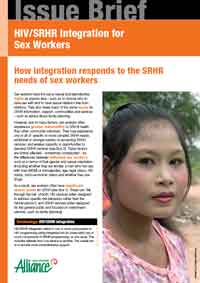How integration responds to the SRHR needs of sex workers
 Sex workers have the same sexual and reproductive rights as anyone else – such as to choose who to have sex with and to have sexual relations free from violence. They also share many of the same needs for SRHR information, support, commodities and services – such as advice about family planning.
Sex workers have the same sexual and reproductive rights as anyone else – such as to choose who to have sex with and to have sexual relations free from violence. They also share many of the same needs for SRHR information, support, commodities and services – such as advice about family planning.
However, due to many factors, sex workers often experience greater vulnerability to SRH ill health than other community members. They may experience one or all of: specific or more complex SRHR needs; additional or stronger barriers to accessing SRHR services; and weaker capacity or opportunities to demand SRHR services . These factors are further affected – sometimes complicated – by the differences between individual sex workers, such as in terms of their gender and sexual orientation (including whether they are female, a man who has sex with men (MSM) or transgender), age, legal status, HIV status, socio-economic status and whether they use drugs.
As a result, sex workers often have significant unmet needs for SRHR. These can ‘fall through the net’ of both: HIV services (often designed to address specific risk behaviors rather than the ‘whole person’); and SRHR services (often designed for the general public and focused on mainstream services, such as family planning).
This brief specifically focuses on the importance, but also challenges, of HIV/SRHR integration for sex workers. It is based on the experiences of a growing number of groups working with such communities to put integration into practice in a range of setting. These have given important insights into ‘what works’. But they also highlight that everyone is still learning and questions remain about what constitutes good practice.
This issue brief promotes integration as a desirable goal in the long-term. However, it also emphasizes that organizations must work in a way and at pace that is appropriate and feasible for them – to ensure that the joining of HIV and SRHR services and systems enhances, rather than compromises, support for sex workers.
This review was commissioned by the India HIV/AIDS Alliance with support from the European Union under the Action Project and explores experiences and lessons from around the world including Asia and the Pacific. This issue brief is part of a series of materials resulting from a review of good practice in the integration of HIV and sexual and reproductive health and rights for key populations.
Download brief from here.
_______________
Alliance India is a state lead partner in Andhra Pradesh for implementing the Avahan India AIDS Initiative (2003-2013) which works in six states of India and is funded by the Bill & Melinda Gates Foundation. The programme aims to reduce HIV transmission and the prevalence of STIs in vulnerable high-risk populations, specifically female sex workers, MSM, and transgenders, through prevention education and services such as condom promotion, STI management, behavior change communication, community mobilization, and advocacy.
Other Recent Articles
- Yoga for Wellness: Supporting People Living with HIV & NCDs 25 June, 2025
- The Unsung Heroes of HIV Care: Outreach Workers under the Vihaan Programme 8 May, 2025
- Men’s Mental Health Matters in HIV Care 1 April, 2025
- Transforming Lives through Health Interventions: My Visit to Narmadapuram Prison 11 July, 2024
- HIV and Ageing: Understanding the Unique Needs of Older Adults 20 May, 2024
- Youth Voices: Life with HIV in Contemporary India 26 September, 2023
- Empowering Transgender Community to create an Equal World 20 July, 2023
- Combating Stigma and Discrimination Among People Living with HIV 7 July, 2023
- Understanding the Significance of HIV Testing: Impact on Individuals, Relationships, and Society 22 June, 2023
- Empowering Lives during Unrest l Our Commitment to Manipur 5 June, 2023
- Made by Nicdark - Copyright 2020
- donations@ong.com
- volunteers@ong.com
- contact@ong.com
India HIV/AIDS Alliance (Alliance India)
A not-for-profit Section 8 Company with Registration No: U85310DL1999NPL098570
Contact
-
6, Community Centre
Zamrudpur Kailash Colony Extension
New Delhi – 110048 - +91-11-4536-7700
Download
©2021 All Rights Reserved by Alliance India



